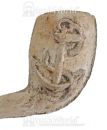We've tried to ensure the information displayed here is as accurate as possible. Should there be any inaccuracies, we would be grateful if you could let us know at info@ipohworld.org . All images and content are copyright.
(Please click on the thumbnail for a bigger image.)
An Introduction To Clay Pipes




Thanks to Sir Walter Raleigh, who brought tobacco to England from Virginia, as a present for Queen Elizabeth I on I 27th July 1586, the deadly habit of smoking soon spread around the world. It was smoked in pipes.
By the mid-17th Century the manufacture of clay pipes was a well an established trade in England and as the British expanded their empire across the world, smoking pipes and tobacco went with them. By 1700, when the industry reached a peak, almost every town and city in England had pipe makers. Millions were being produced not only for local use but also for export. Long pipes were favourite as they allowed a cooler smoke, but also broke more easily and so they were often thrown away on the spot after use.
However it was realised that smoking was harmful to health and Snuff taking in the upper classes became popular and for a while and the habit of smoking declined. Clay pipes came back into fashion again in the 19th Century along with industrial revival and population growth. Pipes became decorated and almost every aspect of everyday life was celebrated on them.
In the 1820’s artisans from the French town of St. Claude in the Jura Mountains, renowned for their wood carving skills, began to produce pipes with bowls made from the burl of the white heath tree. This wood was called “bruyere” and through the years has become known as briar. The Briar pipe was born.
By the 1930’s clay pipes lost to competition from the cigarette and virtually disappeared
The pipes in the photograph are mostly broken pieces in our collection, but one treasure remains complete as shown. It is was probably owned by an old seaman as it features a sailing ship and a fouled anchor.